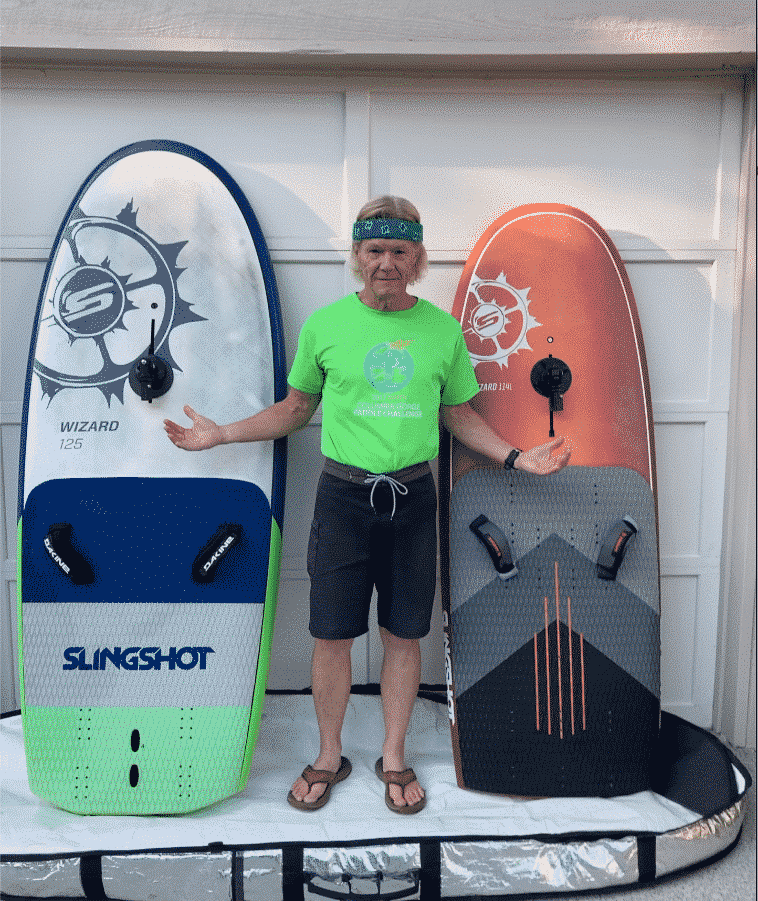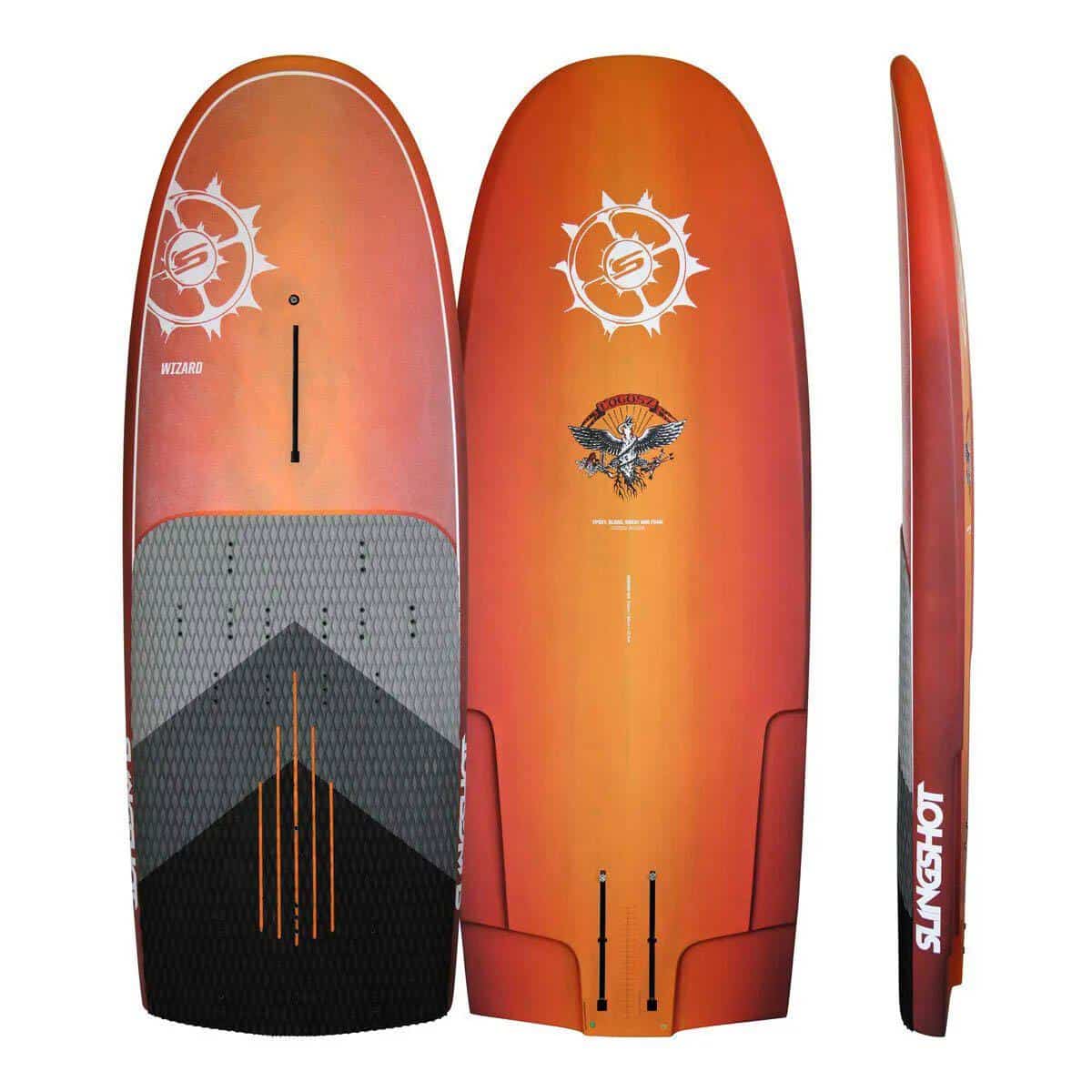The successor to Big Wind’s most popular windsurf foil board. Slingshot’s Wizard V3 features adjustable foil track mounts (not a Tuttle box) to enable riders to perfectly place their foil for balanced riding.
The Wizard 90L is the choice for lighter sailors or high wind foiling addicts, there is nothing like it. The outboard strap options offer blistering speed and crazy tack angles. Inboard footstrap inserts and a centerline back foot option provide complete control for huge lofty airs. If foiling is all you do, this board is for you!
The Wizard 114L was designed to pull away from the wide profile of bulky first-generation foil boards. The narrower outline increases your control, reduces windage, and allows the rider to lay hard carves without a formula board stance. A substantially thicker shape puts the volume under your feet where you need it most, delivering an ultra-compact package with incredible stability.
Whether you like an inboard or outboard stance, tailor the 114L to your style with an array of footstrap options including centerline back foot and forward wingfoiling inserts.
The Wizard 130L improves upon the previous 125L model with reduced length and width, but increased thickness. Floaty enough to uphaul yet compact enough to fit in the back of a station wagon. Designed to provide less swing-weight, more controlled jibing, and increased float under your feet, the 130L is the choice for anyone looking to maximize both performance and light wind takeoff.
WHY YOU’LL LOVE THE WIZARD V3
- It offers the feeling of riding the foil and nothing else
- Built from light and stiff Biax Carbon.
- Boxy volume under your feet, where you need it
- Direct rail to rail responsiveness
- Centerline back footstrap option
- Forward Wingfoiling footstrap inserts
- Adjustable foil track
- Sail Sizes:
90L: 2.5 to 5.3
114L: 3.5 to 7.5
130L: 4.5 to 9.0
SPECS
EXCLUSIVE WIZARD 114 USER REVIEW

In Depth Review: Comparing The 2017 Slingshot Wizard 125 To The New 2021 Slingshot Wizard 114 by Bruce Barry.
Summary: The now dated 2017 Wizard 125 is compared against the brand new Wizard 114. The Wizard 125 continues to be an excellent and highly functional one board quiver with a massive sail range while the 114 is a significant performance improvement, at the price of carrying ability for sail sizes larger than around 5.5 meter.
Qualitative performance observations are based on my cumulative experience of 201 sessions on the Wizard 125, 110 of them with the versatile and forgiving I-76 wing, and 6 sessions on the 114 with the Infinity 76 wing. I have used the 125 with sail sizes from 2.5 to 8.1, with the sweet spot laying between 3.1 and 6.1. Of note is that the somewhat heavy first generation 125 (subsequent years were several pounds lighter) is bullet proof – the primary damage after 201 sessions is simply that the edges of the deck pad are peeling in a few places.
My 6 sessions on the 114 have been on sail sizes from 2.5 to 6.1 in storm front gusty/ holey lake conditions. Observations are believed to be reliable as I set up the 114 straps, foil mount, and mast base literally to the millimeter of the positions that I have locked in on for the 125 and left unchanged for months. Transition to the 114 only took minutes and one foiling reach before it felt comfortable and predictable, and as noted further below with surprising performance attributes.
My background is 60 years of surfing and 30 years of windsurfing. Between these and SUP I am on the water 250 days a year. I am short and light weight, so my physical dimensions, always important to understand how things work for each individual, are 5’7”, 142 pounds, and age 70 next month. These sports have kept me physically aging well below my chronological age.
Order of Review
- Slingshot Marketing Language – how does the manufacturer describe the new Wizard 114.
- Dimensions / Specifications
- Perceived Performance Attributes
- Final Comments
- Slingshot Marketing Language:
“A bit more all around – the all new 114L Wizard will float a bit higher at rest, but still offers insane maneuverability and playfulness (AND you’ll probably be able to get home if the wind dies)! Still totally amazing as a high wind board due to the short length (178cm/5’10”) and moderate width (66cm), and fully useful as a light and medium wind board due to the volume, this is a one board quiver for anyone with experience, in the “average” weight range. Heavyweights will love the 114 as a medium and high wind board!”
- Dimensions / Specifications (new Wiz 130 listed for reference)
- Perceived Performance Attributes: 114 vs 125 Review of the specs shows that the 114 is significantly lighter, shorter with the length cut off the front only, narrower overall, and with (not shown) a narrower tail than the 125. These attributes translate to some interesting advantages (as well as a couple of potential disadvantages,) a few of them not obvious and came as a bit of a surprise to me.
- I am positive that the 114 pumps onto foil quicker than the 125 for every given sail size I have tried from 2.5 to 6.1! All 4 of those attributes noted above seem to come into play to make this happen. I found it initially stunning as my first 114 voyage was on a 5.3 Goya Fringe and I just could not believe how early I was pumping it up.
- The 114 is super responsive on the jibe – for sure again related to the 4 attributes listed above. The 125 generally takes foot placement to the low side for a good solid dry foiling carve, the 114 responds with simply rocking the foot and body English from the sail. A total delight.
- The 114 does not get buffeted by wind gusts. I had not thought the 125 did either, until I was on the 114 and felt the difference. The 114’s quietness on any angle of sail is apparent, significantly so going upwind and thru chop where again the ease of foot control makes everything quickly responsive and effortlessly easier. I even see tacks – easy for me on the 125 – being possible on the 114 if done quickly.
- 8” or so less nose on the 114 is 8” less to stuff in waves going downwind. While slightly disconcerting at first, you get used to it quick. The business of guiding the board all takes place behind the mast.
- And for the downside, uphauling the 114 is progressively more difficult as waves/chop/sail sizes increase. For the same reason as above, put your front foot in front of the straps and you encourage a full frontal nose stuff and/or rapidly rounding upwind. The 125 by contrast is always easy to uphaul.
- Finally and oddly, two sail specs are listed for the 114: 3.5 – 5.2 and 3.5 to 7.5. Both on the same Slingshot website?? While I can sail my 6.1 on the 114 it is not at all comfortable to jibe and really hard to uphaul compared to the free and easy jibing and handling with the 5.3. The extra leverage created by the larger luff and boom lengths is enough to throw the balance off. For perspective both the 5.3 and 6.1 sails are 3 batten wave sails, the super light Hot KS3 6.1 fully rigged only weighs 0.2 pounds more than the 5.3 Fringe – this is truly a leverage and balance problem not one induced by heavier kit – and as noted above I can jibe the 114 with foot pressure while the 125 takes movement of the foot. At any rate the super easy dry foiling jibe combo of 125/6.1 goes to a “rarelymakeum” on the 114/6.1. Then again, referring to the original spec given for the 114 – 5.2 was the upper end. I buy that and depending on the rider can be stretched a bit. My 5.3 on the 114 is a delight.
- Slogging the 5.3 on the 114 is not great, but ok. Slogging the 6.1 on the 114 is challenging. The 6.1 is now reserved for the 125 which is so easy to slog that in theory it could be slogged whilst eating a pizza, with one hand for the ship and one hand for the pizza.
Final Comments
- The 125 is a super solid 1 board quiver, especially for a lighter rider. The usable sail range at my 142# is a massive 2.5 to 8.1 with a comfort range of 2.8 to 7.0. A used 125 or new (probably heavily discounted) 125 would be a great investment, the new 130 also has the potential to be a great board with a massive range of use.
- The 114 is a performance delight with a comfort range of 2.5 to 5.5 ish. Unless you live in a really windy area, this is probably not a 1 board solution.
- I believe the Slingshot 114 marketing copy listed at the opening is not hype, it is a remarkably honest and accurate description of the board.
- A few minor beefs: The mounting plate bolts supplied with the board were too short – 2.75cm supplied vs 3cm required and the footstrap screws appear to be too long – 3.35cm supplied vs estimated 3.15 cm required – the longer screws bottomed out before the straps were fully secured. My best friend Don Ledford drives a Sprinter van fully loaded with tools and parts, presumably to help keep me on the water and he had what was necessary to get me out and going. Everyone needs a Don around☺
- Like all my reviews and health-based writings, feel free to forward. — Bruce Barry 10/22/2020



